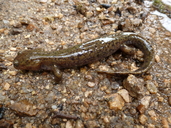|
Description
Batrachuperus tibetanus total length ranges from 175-211 mm in males, 170-197 mm in females. Head is somewhat flat, of equal length and width. Snout is wide and round in shape. Noticeable labial folds present. Vomerine teeth short, with 4-6 on each side, large gap in between the two rows of teeth. Body is either cylindrical in shape or flattened, covered with smooth skin. Jugular fold is obvious, with a groove that runs from the fold to the posterior of each eye. Generally 12 costal grooves are present. There is a distance of 1-2 costal grooves between the tips of forelimb and hindlimb toes when limbs are adpressed to the flank. There are four unwebbed toes on each forelimb and four unwebbed toes on each hindlimb, with dark brown coloration at the tips of the toes. In males, tail length exceeds SVL; however females have a longer SVL than the tail. The tail is cylindrical in shape, flattening out towards the oval-shaped tip (Fei and Ye 2001).
Body color varies in this species; dorsum of the body and the tail is usually either dark yellow, dark gray, or olive gray. Some specimens will also have tiny black dots on the dorsum. The venter is lighter in color (Fei and Ye 2001).
Larvae develop a tailfin fold when they reach 41 mm in length. The tri-forked gills disappear at 64 mm in length, when larvae enter the adult stage (Fei and Ye 2001).
Distribution and Habitat
Country distribution from AmphibiaWeb's database: China
This species occurs in China, within the provinces of Sichuan, Xiaxi, Qinghai, Xizang, and Gansu. It is found in highlands or mountain creeks, near water and rocks, at elevations from 1,500-4,250 m above sea level. During the day, Batrachuperus tibetanus hides underwater beneath rocks or rotten wood (Fei and Ye 2001). Life History, Abundance, Activity, and Special Behaviors
Oviposition occurs from May to July. The female lays a pair of egg sacs, attaching one end onto rocks or rotten wood. There are 16-25 eggs in each egg sac, and 36-50 eggs in total. Egg sacs are spiral-shaped and have wrinkled surfaces. Egg sacs range from 102-140 mm in length, and 10-12 mm in diameter. Eggs themselves are 3.7 mm in diameter, and light yellow in coloration (Fei and Ye 2001). Trends and Threats
Threatened by intense collection for food and medicine (Fei and Ye 2001), though part of the range falls within protected areas (IUCN 2008). Other threats include habitat loss and pollution due to mining (IUCN 2008). Possible reasons for amphibian decline General habitat alteration and loss
Habitat modification from deforestation, or logging related activities
Intensified agriculture or grazing
Mining
Dams changing river flow and/or covering habitat
Local pesticides, fertilizers, and pollutants
Intentional mortality (over-harvesting, pet trade or collecting)
References
Fei, L. and Ye, C. (2001). The Colour Handbook of the Amphibians of Sichuan. Chinese Forestry Publishing House, Beijing.
Fu, J., Wang, Y., Zheng, X., Liu, Z. and Zheng, Y. (2001). ''Genetic diversity in the eastern Batrachuperus (Caudata: Hynobiidae).'' Copeia, 4, 1100-1107.
Originally submitted by: Michael Li (first posted 2008-10-14)
Edited by: Kellie Whittaker (2016-06-02)Species Account Citation: AmphibiaWeb 2016 Batrachuperus tibetanus: Alpine Stream Salamander <https://amphibiaweb.org/species/3875> University of California, Berkeley, CA, USA. Accessed Apr 20, 2024.
Feedback or comments about this page.
Citation: AmphibiaWeb. 2024. <https://amphibiaweb.org> University of California, Berkeley, CA, USA. Accessed 20 Apr 2024.
AmphibiaWeb's policy on data use.
|





 Raffaëlli Account
Raffaëlli Account Map of Life
Map of Life